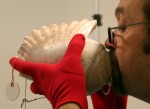
Archaeologists found twenty intact conch shell trumpets at a site in the Andes Mountains. They tested them to determine how they could be played and what sounds they could make:
As an expert shell musician blew into the horn, researchers recorded the sound’s path via four tiny microphones placed inside the player’s mouth, the shell’s mouthpiece, the shell’s main body and at the shell’s large opening, or bell. Similar to a bugle, the instruments only sound one or two tones, but like a French horn, the pitch changes when the player plunges his hand into the bell.
The team used signal-processing software to characterize the acoustic properties of each trumpet. Following the sound’s path made it possible to reconstruct the ancient shell’s interior, a feat that normally involves sawing the shell apart or zapping it with X-rays.

No comments:
Post a Comment